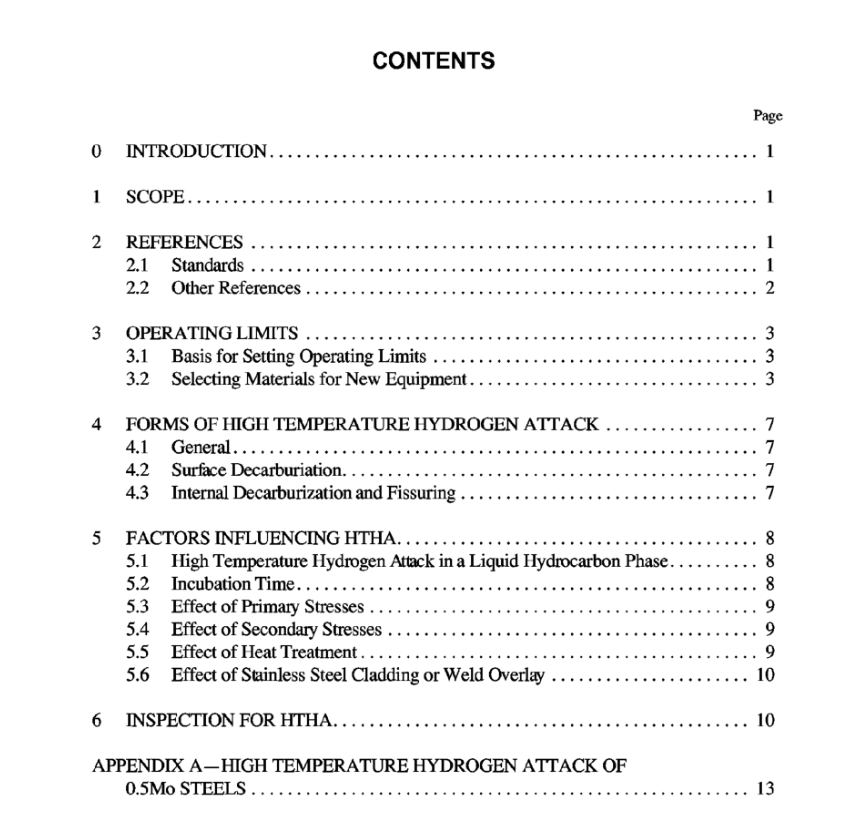API 941 pdf download

API 941 pdf download.Steels for Hydrogen Service at Elevated Temperatures and Pressures in Petroleum Refineries and Petrochemical Plants
1 Scope
This recommended practice summarizes the results of experimental tests and actual data acquired from operating plants to establish practical operating limits for carbon and low alloy steels in hydrogen service at elevated temperatures and pressures. The effects on the resistance of steels to hydro- gen at elevated temperature and pressure that result from high stress, heat treating, chemical composition, and cladding are discussed. This recommended practice does not address the resistance of steels to hydrogen at lower temperatures (below about 400°F [204°C]), where atomic hydrogen enters the steel as a result of an electrochemical mechanism. This recommended practice applies to equipment in refin- crics, petrochemical facilities, and chemical facilities in which hydrogen or hydrogen-containing fluids are processed at elevated temperature and pressure. The guidelines in this recommended practice can also be applied to hydrogenation plants such as those that manufacture ammonia, methanol, edible oils, and higher alcohols. Hydrogenation processes usually require standards and materials that may not be warranted in other operations of the petroleum industry. At certain combinations of elevated tem- perature and hydrogen partial pressure, both chemical and metallurgical changes occur in carbon steel, which in advanced stages can render it unsuitable for safe operation. Alloy steels containing chromium and molybdenum can be used under such conditions. The steels discussed in this recommended practice resist HTHA when operated within the guidelines given. However, they may not be resistant to other corrosives present in a pro- cess stream or to other metallurgical damage mechanisms operating in the high temperature hydrogen attack range. This recommended practice also does not address the issues sur- rounding possible damage from rapid cooling of the metal after it has been in high temperature, high pressure hydrogen service (e.g., possible need for outgassing hydroprocessing reactors). This recommended practice will discuss in detail only the resistance of steels to high temperature hydrogen attack. Presented in this document are curves which indicate the operating limits of temperature and hydrogen partial pressure for satisfactory performance of carbon steel and CrMo steels in elevated temperature, hydrogen service. In addition, it includes a summary of inspection methods to evaluate equip- ment for the existence of HTHA.
3 Operating Limits
3.1 BASIS FOR SE1 rTING OPERATING LIMITS Figure 1 ilustrates the resistance of steels to attack by hydrogen at elevated temperatures and hydrogen pressures. As explained below, high temperature hydrogen attack of steel can result in surface decarburization, intemal decarbur- ization and fissuring, or both. Figure 1 gives the operating conditions (process temperature and hydrogen partial pres- sure) above which these types of damage can occur. Figure 1 is based upon experience gathered since the 1940s. Supporting data were obtained from a variety of com- mercial processes and laboratory experiments (see the refer- ences to Figure 1). While temperature and hydrogen partial pressure data were not always known precisely, the accuracy is often sufficient for commercial use. Satisfactory perfor- mance has been plotted only for samples or equipment exposed for at least one year. Unsatisfactory performance from laboratory or plant data has been plotted regardless of the length of exposure time. The chemical compositions of the stecls in Figure 1 should conform to the limits specified for the various grades by ASTM or ASME. Since the original version of Figure 1 was prepared for API in 1949,1 further experience has enabled curves for most commonly used steels to be morc accurately located. A major exception has been for C-0.5Mo steel. This edition consoli- dates all information relevant to 0.5Mo steels (C-0.5Mo and Mn-0.5Mo) in Appendix A. The fth edition of this recommended practice also added three data points, which show high temperature hydrogen attack of 1.25Cr-0.5Mo steel below the current 1 .25Cr-0.5Mo curve. See Appendix B for more discussion of 1.25Cr-0.5Mo steel. Appendix C gives a similar discussion for 2.25Cr- 1.0Mo steel.









